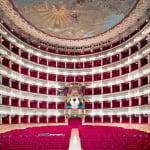
Candida Höfer German, b. 1944
Teatro San Carlo Napoli I 2009
C-print
200 x 285 cm. (78 3/4 x 112 1/4 in.)
Edition of 6 (#6/6)
Copyright The Artist
Further images
In Teatro San Carlo Napoli I 2009, Candida Höfer turns her gaze to one of the most storied sites in the history of European performance. Founded in 1737, the Teatro...
In Teatro San Carlo Napoli I 2009, Candida Höfer turns her gaze to one of the most storied sites in the history of European performance. Founded in 1737, the Teatro San Carlo in Naples holds the distinction of being the world’s oldest active opera house, a seminal prototype that influenced countless theatres across the continent. Höfer’s photograph, one of twenty-one captured during her exploration of Naples, invites us into this architectural palimpsest, where centuries of performance and spectatorship are inscribed onto the very surfaces of its Neoclassical interior.
In Teatro San Carlo Napoli I 2009, the artist captures the lavishness of the six-tiered balconies, the rich Lucullan blue upholstery, and the gilded ornamentation that glimmers in the diffused light. Höfer isolates and transforms these elements into a system of signifiers, calling attention to the opera house as a site where social hierarchies, cultural aspirations, and the rituals of spectatorship intersect. The geometry of the photograph is paramount. Höfer positions the viewer in a symmetrically centralised perspective, aligning our gaze with the proscenium arch and extending the theatre’s vanishing point far beyond the stage. This compositional device not only underscores the theatre’s architectural grandeur but also implicates the viewer as a participant in its space. The empty seats, arranged with rigid formality, become placeholders for an absent audience, whose presence is felt even in its void.
Light, always critical in Höfer’s work, assumes a particular resonance here. The photograph captures an ambient glow, soft and diffused, which lends the space an almost spectral quality. This light, filtered through the theatre’s ornate chandeliers and intricate latticework, animates the golden panoplies and imbues the scene with a sense of anticipation. The emptiness is not hollow but charged, suggesting the imminent return of life to the stage and stalls. Höfer’s Teatro San Carlo Napoli I 2009 is thus both an image of absence and a meditation on presence. It explores the opera house as an architectural form designed not merely to house performances but to orchestrate human behaviour, structuring the ways in which bodies inhabit space and interact with spectacle. Her photograph reframes this interior not simply as an aesthetic achievement but as a social and cultural apparatus, an enduring emblem of the ways in which architecture materialises collective aspiration.
In this sense, the work operates as a kind of visual archaeology. Höfer excavates layers of history embedded in the sumptuous surfaces of the theatre, asking us to consider not only what is visible but also what lies latent: the accumulated gestures, voices, and silences that have animated this space across centuries. By capturing the Teatro San Carlo in this suspended state, Höfer grants us a moment to reflect on the temporal and spatial dynamics of performance, and the role of architecture in shaping cultural memory.
In Teatro San Carlo Napoli I 2009, the artist captures the lavishness of the six-tiered balconies, the rich Lucullan blue upholstery, and the gilded ornamentation that glimmers in the diffused light. Höfer isolates and transforms these elements into a system of signifiers, calling attention to the opera house as a site where social hierarchies, cultural aspirations, and the rituals of spectatorship intersect. The geometry of the photograph is paramount. Höfer positions the viewer in a symmetrically centralised perspective, aligning our gaze with the proscenium arch and extending the theatre’s vanishing point far beyond the stage. This compositional device not only underscores the theatre’s architectural grandeur but also implicates the viewer as a participant in its space. The empty seats, arranged with rigid formality, become placeholders for an absent audience, whose presence is felt even in its void.
Light, always critical in Höfer’s work, assumes a particular resonance here. The photograph captures an ambient glow, soft and diffused, which lends the space an almost spectral quality. This light, filtered through the theatre’s ornate chandeliers and intricate latticework, animates the golden panoplies and imbues the scene with a sense of anticipation. The emptiness is not hollow but charged, suggesting the imminent return of life to the stage and stalls. Höfer’s Teatro San Carlo Napoli I 2009 is thus both an image of absence and a meditation on presence. It explores the opera house as an architectural form designed not merely to house performances but to orchestrate human behaviour, structuring the ways in which bodies inhabit space and interact with spectacle. Her photograph reframes this interior not simply as an aesthetic achievement but as a social and cultural apparatus, an enduring emblem of the ways in which architecture materialises collective aspiration.
In this sense, the work operates as a kind of visual archaeology. Höfer excavates layers of history embedded in the sumptuous surfaces of the theatre, asking us to consider not only what is visible but also what lies latent: the accumulated gestures, voices, and silences that have animated this space across centuries. By capturing the Teatro San Carlo in this suspended state, Höfer grants us a moment to reflect on the temporal and spatial dynamics of performance, and the role of architecture in shaping cultural memory.
5
of
5
